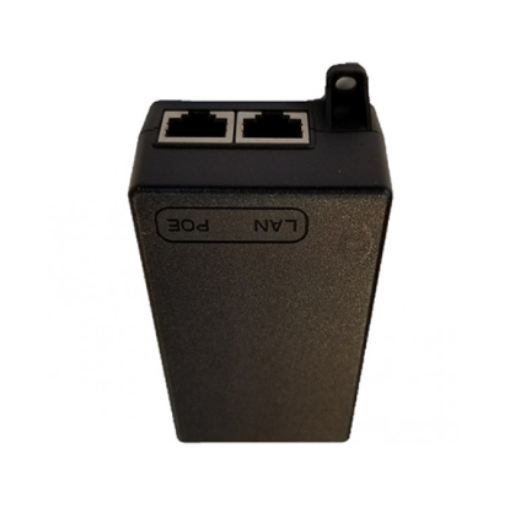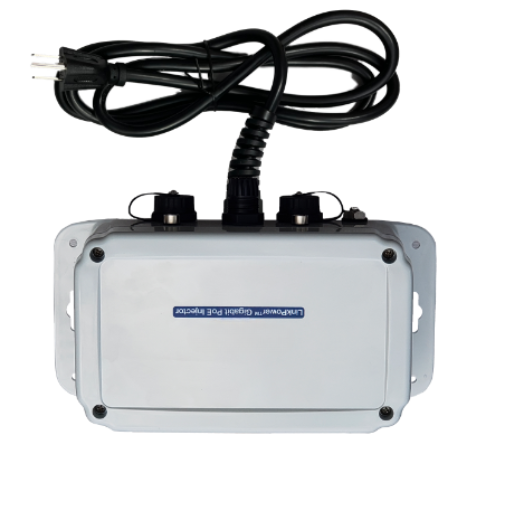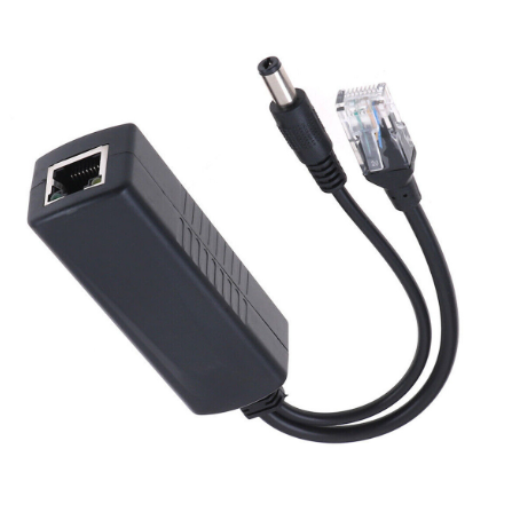PoE stands for Power over Ethernet, a technology that enables the transmission of both power and data over Ethernet cables. PoE is an innovative solution that eliminates the need for traditional power supplies and electrical outlets, adding greater convenience and flexibility in network installation.
Power over Ethernet (PoE) technology allows electrical power to be transmitted through Ethernet cables, supplying data and power to network devices. Using a single Ethernet cable, PoE technology makes it possible to power devices, such as IP security cameras, wireless access points, VoIP phones, bright lighting, and other powered devices.
PoE uses the existing Ethernet infrastructure to deliver power to network devices. PoE-enabled switches supply power to connected devices by transmitting a low-voltage electrical current over the Ethernet cable while providing data communication. This technology is achieved by modulating the DC voltage level onto one or more wires within the Ethernet cable. The receiving device then demodulates this voltage, extracting the power and data.
PoE technology has numerous benefits, including cost savings, flexibility, reliability, and scalability. With PoE, businesses can save thousands of dollars by reducing the number of power outlets, electrical wiring, and power supplies typically required to power network devices. PoE also provides greater flexibility in device location, making installing appliances in hard-to-reach places easier without needing power outlets or extension cords. PoE eliminates the risk of power outages affecting critical devices, ensuring they are always online and operational. With PoE, businesses can quickly scale their network while avoiding the costs of additional power infrastructure.
PoE technology has become essential in many industries and applications, including IP security cameras, wireless access points, VoIP phones, bright lighting, and other powered devices. PoE is beneficial in scenarios where it is difficult or expensive to install additional power sources. For example, installing traditional power outlets and wiring around the facility in a security camera application can be time-consuming, costly, and disruptive. Still, with PoE, it’s simple to run Ethernet cables. Similarly, in an intelligent lighting application, PoE enables the installation of brilliant light fixtures anywhere without needing a nearby power source.
A PoE injector, also known as a Power over Ethernet injector, is an electronic device that enables the transmission of both data and power over a single Ethernet cable. The device allows network administrators to power devices such as VoIP phones, security cameras, and wireless access points without needing an external power source.
Recommended Reading: What Is Poe Switch: Everything You Need to Know
The primary function of a PoE injector is to provide power to devices equipped with Power over Ethernet technology. Without PoE injectors, these devices would require a separate power supply, adding an extra layer of complexity to network topology.
A PoE injector works by inserting power into the Ethernet cable and transmitting the power along with the data. This is achieved by using what is known as phantom power, which signals the receiving device to use the unused wire pairs in the Ethernet cable for power transmission.
There are two primary types of PoE injectors: single-port and multi-port injectors. Single-port injectors are designed to power a single device, whereas multi-port injectors can power multiple devices simultaneously. Additionally, there are midspan and endpoint injectors. Midspan injectors are placed between the Ethernet switch and the device, while endpoint injectors are placed between the device and the Ethernet switch.
One of the key advantages of using a PoE injector is its ability to reduce cabling and installation costs. Because PoE injectors allow devices to be powered without additional power cords, fewer cables are required in the network infrastructure. Additionally, installing PoE injectors saves labor costs since technicians do not need other outlets or power cords.
Another advantage of PoE injectors is their flexibility. Because PoE devices can be powered from a central location, they can be easily moved and relocated without additional rewiring or electrical outlets.
Compatibility with devices is one consideration when using PoE injectors. Not all devices are PoE compatible, so ensure the device is compatible with PoE technology before using a PoE injector. Power limitations should also be considered, as PoE injectors have limited power output. Make sure to check the power requirements of the device before purchasing and using a PoE injector.
Lastly, safety measures should be considered, including surge protection, short-circuit protection, and overcurrent protection; these measures help prevent damage to devices powered by PoE injectors and protect against potential hazards such as electrical fires.
PoE Injectors serve as bridge devices when connecting PoE-powered devices to a non-PoE network.

Firstly, identify the PoE injector’s input and output ports. The input port is where the Ethernet cable from the non-PoE switch/router is connected, while the output port is where the Ethernet cable from the PoE-powered device is connected.
Next, connect the Ethernet cable from the non-PoE switch/router to the input port of the PoE injector.
Then, connect the Ethernet cable from the PoE-powered device to the output port of the PoE injector.
Power on the PoE injector, automatically detecting the PoE-powered device and providing the necessary power supply.
Before using a PoE injector, ensure that the devices to be connected are compatible. This includes checking for the appropriate Ethernet cables, power supply, and network adapter.
It is also essential to verify the wattage requirements of the PoE-powered device to ensure that the PoE injector can provide enough power to operate the device entirely.
A PoE injector can be used with PoE devices and non-PoE devices. However, a PoE splitter is necessary to split the power and data signal with non-PoE devices.
When using a PoE injector, there is a possibility of overloading the device if the power supply from the PoE injector does not match the wattage requirement of the device. This can lead to device failure or damage.
Another potential issue is the distance limitation between the PoE injector and the PoE-powered device, as it can affect the power delivery and quality of the signal. Therefore, it is essential to check the distance limitations of the PoE injector before use.
Additionally, when using non-PoE devices with a PoE injector, it is crucial to use a PoE splitter to avoid signal interference and ensure compatibility.
If the PoE-powered device does not power on, ensure that the PoE injector is providing the correct power supply required by the device.
If the device is not receiving a connection, ensure that the Ethernet cables are connected correctly and the device is within the recommended distance of the PoE injector.
If issues persist, contact the manufacturer’s technical support for further assistance.
A PoE injector is a device that injects power into an Ethernet cable to power a PoE-enabled device. However, there are a few alternatives to a PoE injector, including:
PoE Switch: A PoE switch is a network switch that integrates PoE functionality, allowing you to power multiple PoE-enabled devices from a single device. This is ideal for network installations where many devices, such as security camera installations or enterprise wireless access point networks, must be powered.
Midspan: A PoE midspan is a device that sits between a non-PoE switch and a PoE-enabled device, injecting power into the Ethernet cable. This option is useful when you already have a non-PoE button and must power multiple PoE devices without replacing the entire switch.
Power-over-HDBaseT (PoH): PoH is a technology that uses HDMI or HDBaseT cables to transmit power and data over a single line. This option is helpful for HDMI connectivity devices, such as audio and video equipment.

A PoE splitter is a device that separates power and data from an Ethernet cable, allowing you to power a non-PoE device with PoE. It has two Ethernet ports, one for data and one for power. The power port receives power from the PoE-enabled Ethernet cable and then feeds it to the non-PoE device through its power supply.
A PoE splitter uses a process known as “demarcation” to separate power and data from an Ethernet cable. The splitter has two Ethernet ports labeled “Data In” and “Power + Data Out.” You connect the PoE cable to the “Data In” port to receive power and data. The PoE splitter separates the energy from the data, sends it back through the “Data Out” port, and then feeds the power to the non-PoE device through its power supply, connected to the “Power + Data Out” port.
A PoE splitter and a PoE injector have some similarities but differ in how they supply power to devices. The differences are:
Power direction: A PoE injector injects power into an Ethernet cable, while a PoE splitter separates power from data to provide power to a non-PoE device.
Number of Ethernet ports: A PoE injector has one Ethernet port, while a PoE splitter has two Ethernet ports.
Device compatibility: A PoE injector is universal and can power any PoE-enabled device, while a PoE splitter can only power non-PoE devices.
A PoE splitter is functional when powering non-PoE devices using PoE. This is especially useful when you have an existing non-PoE device you want to power using PoE, such as a VoIP phone, IP camera, or access control system. Another situation where a PoE splitter is functional is when the PoE source has limited power that cannot meet all the devices’ power requirements.
Device Compatibility: Not all PoE splitters are compatible with all PoE switches, so you need to ensure compatibility before purchasing. This will avoid compatibility issues that may arise when using different PoE devices.
Maximum Power Consumption: PoE splitters have a maximum power consumption rating that denotes how much power they can handle. You need to check the power requirements of your devices and ensure that the splitter can handle the power requirements of all devices attached to it.
Port Configurations: PoE splitters have different port setups, including Gigabit Ethernet, Fast Ethernet, and 10/100Mbps ports. You need to ensure that the port configuration of the PoE splitter matches the device’s port configuration to avoid network congestion or speed reduction.
Recommended Reading: Fiber optic access network WAN connection topology design
PoE has a wide range of applications in networking, including:
IP Telephony: PoE enables IP telephones to receive power and data over the same Ethernet cable, eliminating the need for a traditional power outlet.
Wireless Networks: PoE injectors power Wireless Access Points (WAPs) and allow data transmission, providing flexibility with device location and reducing installation time.
IP Cameras: PoE injectors power IP cameras and provide data transmission over the same Ethernet cable, eliminating the need for additional power sources.
Network Hubs and Switches: PoE injectors deliver power and data to network switches and hubs, providing network redundancy and simplifying installation.
LED Lighting: PoE technology can power LED lighting, allowing for easy installation and remote control.

PoE injectors are used in IP cameras as an alternative to connecting them to a traditional power outlet. PoE injectors deliver power over the same Ethernet cable as the data transmission, providing a single cable connection. This simplifies installation and reduces the need for additional power sources. A PoE injector typically comes with an input connector that connects it to a power source and an output connector to the IP camera.
The IP camera must be PoE compatible to use PoE injectors in IP cameras. A PoE-compatible IP camera can be connected directly to a PoE switch, or a PoE injector can click the IP camera to a standard controller. PoE injectors come in various power outputs, depending on the IP camera’s power requirements and distance from the controller.
PoE injectors power wireless access points (WAPs) and enable data transmission over the same cable. This eliminates the need for additional power sources, simplifying installation and reducing cable clutter.
To use PoE injectors in WAPs, the WAP must be compatible with PoE technology. The PoE injector is connected to a power source input, the WAP output and the Ethernet cable are connected to both ends of the PoE injector. PoE injectors come in various power outputs, depending on the WAP’s power requirements and distance from the switch.
PoE injectors power security cameras and enable data transmission over the same cable, providing a single cable connection for both power and data. This simplifies installation and reduces the need for additional power outlets.
The camera must be PoE compatible to use PoE injectors in security cameras. A PoE injector is then connected to a power source input, the camera output, and the Ethernet cable is connected to both ends of the PoE injector. PoE injectors come in various power outputs, depending on the camera’s power requirements and distance from the switch.
PoE injectors power network switches, providing a single cable connection for power and data transmission. PoE injectors come in various power outputs, depending on the switch’s power requirements.
To use PoE injectors in network switches, the PoE injector is connected to a power source input and the switch output, and the Ethernet cable is connected to both ends of the PoE injector.
PoE injectors can also be used in other network devices, including VoIP phones, routers, bridges, and network extenders. PoE injectors come in various power outputs, depending on the device’s power requirements and distance from the switch.
PoE injectors in other network devices provide the same benefits as IP cameras, wireless access points, and security cameras: they simplify installation, reduce cable clutter, and save money on additional power outlets.
Following safety guidelines to prevent injury or damage is essential when working with electrical equipment. Before installing PoE injectors, consult the manufacturer’s safety and installation guidelines. Always wear appropriate protective gear, including rubber gloves, safety glasses, and grounding wrist straps.
When connecting PoE injectors, ensure that the correct voltage is being used and that it matches the device’s power requirements. Avoid overloading the PoE injector or connecting more devices than it can handle. Finally, always disconnect the PoE injector from the power source before connecting or disconnecting any cables.
Recommended Reading: SFP+ Module: Everything You Need to Know

A: A PoE injector is a device that allows you to power a PoE-enabled device, such as an IP camera or a wireless access point, using a standard Ethernet cable.
A: A poe injector injects power into the Ethernet cable, which is then delivered to the poe-enabled device.
A: The advantages of using a POE injector include: – Simplified installation as only one cable is required for both data and power – Flexibility to position devices anywhere, even without a nearby power outlet – Cost savings by eliminating the need for additional power cables or outlets
A: A PoE injector injects power into an Ethernet cable to power PoE-enabled devices, while a PoE splitter separates the power and data signals from the Ethernet cable and delivers them to separate ports.
A: No, a poe injector should only be used with poe-enabled devices. Using a PoE injector with a non-PoE device may cause damage to the device.
A: IEEE 802.3af and 802.3at are standards for power over Ethernet. 802.3af provides up to 15.4 watts of power per port, while 802.3at offers up to 30 watts of power per port.
A: Yes, gigabit poe injectors that are compatible with gigabit Ethernet networks are available.
A: A POE injector requires a power supply compatible with the power output needed for your specific POE application.